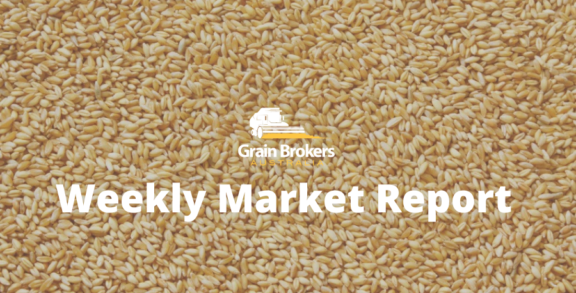
It is tough to find a 2022/23 wheat crop anywhere that is currently getting bigger, with drought or flooding rains a common theme globally. So, it was no surprise to see the United States Department of Agriculture take reduced supplies, lower domestic use, higher exports and reduced ending stocks in their 2022/23 wheat quadrella when the first cut of next season’s supply and demand estimates were released last week.
The latest World Agricultural Supply and Demand Estimates pegged global wheat production at 774.83 million metric tonne, down from the current 2021/22 forecast of 779.29MMT. Domestic consumption worldwide is projected to be 787.52MMT, down from 790.79MMT in the current season. The exports forecast was 5MMT higher than 2021/22 at 204.89MMT, and ending stocks came in 12.7MMT lower than 2021/22 at 267.02MMT.
One of the biggest surprises in the last week’s report was Indian production at 108.5MMT, down just over one million metric tonne from last year’s record harvest. This comes despite heatwave conditions reportedly decreasing yields in the main production states in the country’s north. Many analysts suggest the crop could easily be below 100MMT already, with 93MMT the lowest number I have seen published to date.
Not 24 hours after the May WASDE was released, the global wheat export number was abruptly pushed 8.5MMT lower, with the Indian government announcing a ban on wheat exports with immediate effect. A notice in the government gazette by the directorate of foreign trade, dated Friday, May 13, said a rise in global wheat prices was threatening the food security of India and that of neighbouring countries.
On Saturday, senior government officials announced that India would still honour exports backed by letters of credit already issued and to countries that request supplies “to meet their food security needs”. The officials said that while the decision could be revised, unregulated exports had led to a sharp rise in the local price of wheat. They stated that India’s grain stocks are well above the buffer levels and the decision to regulate wheat exports was taken largely to check prices and curb hoarding. Economics 101 says that is exactly what their actions will provoke.
Apart from problems with weather-damaged harvest, India’s vast stocks of wheat – a buffer against domestic famine – were drained by the distribution of free grain to around 800 million people during the coronavirus pandemic. In a normal year, the government’s food welfare package usually requires around 25MMT to feed the 80 million residents on the program.
Although not one of the world’s top wheat exporters, India has exported close to 10MMT since July 1 last year. The ban will undoubtedly be a bullish signal to the market and could drive global prices to new peaks, given supply is already tight. This will hit the poor consumers in Asia and Africa particularly hard but could also severely impact India itself if this year’s production is so poor, and stocks so low that it has to turn importer.
Governments across the globe are compounding the crisis with protectionism. Since Russia invaded Ukraine in late February, at least 20 countries have imposed restrictions on food exports, covering around 17 per cent of calories traded globally. Such trade restrictions risk setting off a domino effect, driving up prices for everyone.
Meanwhile, the production issues are not restricted to India. Dryness across the US hard red winter wheat area and floods in the hard red spring areas suggest that the USDA yield, and therefore the US production forecast, could be optimistic. The winter wheat abandonment is the highest since 2002, with Texas and Oklahoma the worst affected.
Up north in Minnesota and the eastern reaches of North Dakota, too much rain is preventing farmers from planting their spring wheat crop. As of May 9, only 2 per cent of the spring wheat area had been planted in Minnesota, compared to 93 per cent in the same week last year and a five-year average of 50 per cent. The story in North Dakota is only slightly better, with 8 per cent planted against 63 per cent last year and a five-year average of 37 per cent. We will get to a point where the season will simply be too short to grow a crop, and the prevent plant area will soar.
The US spring wheat issues extend north into Manitoba, Canada, where massive snowfalls in April boosted soil moisture to such a degree that fields are now too wet for planting. A recent grower survey suggested that the spring wheat area would jump by 10 per cent to 7.37 million hectares, but this is now being jeopardised by wet fields and the forecast of excessive rainfall through to the end of May.
Ironically, on the western side of the grain belt, around one-quarter of Alberta’s cropland is still in the grips of drought, too dry to plant this year’s spring crops. These issues alone will make the USDA’s reversion to trend production for Canada in last week’s WASDE report a challenging ask this year.
In Europe, low rainfall in parts of France and Germany has brought the threat of drought, triggering a possible drop in European Union wheat output and exports and raising fears of a further squeeze on global supplies. The USDA’s Russian wheat output of 80MMT is achievable, but exports of 39MMT equate to 3.25MMT per month, around 60 per cent higher than the export pace since the invasion of Ukraine and the burden of Western sanctions. The Ukraine production and export estimates of 21.5MMT and 10MMT, respectively, are an optimistic guess at best for now.
All that said, China’s wheat harvest commences next month, and it is possibly the biggest uncertainty facing the global wheat market in the coming months. It has been extremely dry for the past six weeks in much of the North China Plain, the key wheat-growing region of the country, accounting for 60-70 per cent of national production. There are reports of crops being cut for silage as the grain production prospects were poor. It is always hard to know what is happening in China, but if they say the crop is fine and immediately turn buyer, the game may be on.
That leaves the southern hemisphere powerhouses of Argentina and Australia. The USDA pencilled the former in for 20MMT of wheat against domestic forecasts of 19MMT and a record of 22.15MMT in 2021/22. The USDA stuck their neck out big time for the latter, printing the highest ever first cut wheat estimate for Australia of 30MMT. This is down from the USDA’s conservative 2021/22 number of 36.3MMT, itself a record but at least 3MMT shy of reality.
It is hard to disagree with the USDA at this stage of the campaign, with a better than average soil moisture profile across almost the entire wheat belt. The biggest challenge could well be too much rain, with parts of northern New South Wales and southern Queensland currently far too wet to get remotely close with a planter. Should that situation continue beyond mid-June, a substantial area will swing out of winter crop to an early summer crop plant.
Call your local Grain Brokers Australia representative on 1300 946 544 to discuss your grain marketing needs.





